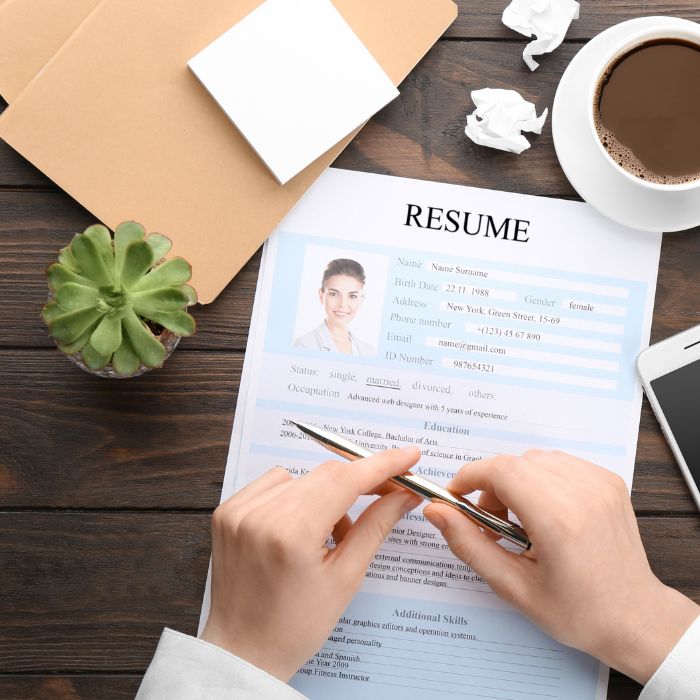How to Navigate Informal Interviews – A Beginner Marketer’s Guide
Heads up, folks! We are reader-supported. Some of the links are affiliate links. We may earn a commission If you click and make a purchase; see our privacy policy for details.
An informal interview might throw you off at first with its casual vibe, but it’s a strategic tool in the hiring process. Picture it as a more relaxed chat often set in a laid-back environment like a coffee shop or virtually, where the usual corporate stiffness is swapped for a friendlier tone. However, don’t let the casual setting fool you; it’s an opportunity for an employer to suss out your fit for their team without the usual formality of a structured interview.
This type of interview often serves as a preliminary meet-up, letting both you and the prospective employer gauge mutual interest without the heavy commitment of formal proceedings. While it may seem conversational, every question is a chance to showcase your skills and personality. Think of it as grabbing a cuppa with someone keen to know your professional story – the goal is still very much about landing the job, but the atmosphere is more ‘getting to know you’ than ‘interrogation under the spotlight’.

So, what’s the best way to nail an informal interview? Treat it like any other crucial step in your career path. It’s less about suiting up and reciting the perfect answers and more about showing how well you’d slot into their company culture. Show up as your best professional self, but don’t be afraid to let your personality shine through. That genuine connection you make could just be what sets you apart from the rest.
Understanding Informal Interviews
When navigating the job market, it’s essential to distinguish between the laid-back nature of an informal interview and the structured approach of a formal one. Understanding this difference can be pivotal in your job search, equipping you with the knowledge to prepare adequately and achieve success.
Defining Informal vs Formal Interviews
An informal interview, also known as an unstructured interview, is a relaxed conversation more than it is a traditional interview. Here, the setting is less intimidating, which may be a coffee shop or a casual office sit-down. The unstructured interview lacks a set list of questions, giving you more room to express yourself freely. On the flip side, a formal interview or a structured interview is marked by a clear-cut, pre-defined format, with specific questions designed to evaluate candidates uniformly.
Common Purposes of Informal Interviews
Your encounter with an informal interview often serves a dual purpose. Firstly, it’s a chance for employers to suss out your personality and see if you’d fit in their team. Simply put, they’re keen to know what makes you tick. Secondly, consider this as your opportunity to gain insights into the company’s culture and values. This can be incredibly telling if you’re pondering whether their work environment is one where you could thrive and grow.
Informal Interview in the Recruitment Process
Throughout the hiring process, an informal chat might pop up at different stages. Some companies prefer kicking things off with an unstructured natter to break the ice before diving into more formal realms. It’s vital to remember that even if the atmosphere feels more relaxed, you’re still being considered for a role. Use this time wisely to discuss your career aspirations and demonstrate the unique skills you bring to the table, all while showing interest in the role and the company.
Preparing for an Informal Interview
Navigating an informal interview can be a bit less structured than a formal one, but it’s just as crucial to make a solid impression. By diving into research and preparation, you’ll chat with confidence, knowing you’ve got a strong grasp of the company, your own questions, and the job role you’re discussing.
Researching the Company

Start by thoroughly looking into the company. Visit the company website and scrutinise not just the homepage, but also recent news, blogs, and their ‘About Us’ section to understand their milestones and values. This will give you insight into the company culture and recent achievements. Highlight any areas where your skills and experiences align with their journey and ethos.
Preparing Your Questions
Prepare some informal interview questions to show you’re engaged and genuinely interested. Consider asking about the day-to-day realities of the role, future projects, or the team you’ll be part of. It’s a good tactic to create a dialogue that goes beyond the job description, showing that you’re thinking about the role in the context of the company’s broader goals.
Understanding the Job Role
Gain a clear understanding of the job you’re discussing by reading the job description carefully. Identify the key responsibilities and think about how you’ve tackled similar challenges in your past roles. Expect to answer some common interview questions about your experience, and use your understanding of the role to discuss where you would fit in and how you can contribute to the company’s objectives.
Conducting an Informal Interview
When inviting someone for an informal interview, your aim is to create a relaxed setting to discuss their potential fit with the organisation. It’s about finding a balance between a professional conversation and a casual chat, all while gathering valuable insights.
Choosing the Right Environment
If you get an opportunity to suggest a venue, opt for a venue where you can have a constructive conversation without the pressure of a formal office environment. A coffee shop can be an ideal choice, offering a neutral ground that’s conducive to open dialogue. Ensure the space is quiet enough for both parties to hear each other without shouting, yet private enough to maintain confidentiality. Keep in mind the location’s convenience for the candidate, aiming for a spot that is easily accessible for them.
Active Listening and Body Language

Active listening is key in an informal chat. You want to fully engage with the candidate, showing interest in what they have to say. Maintain eye contact, nod to acknowledge points, and avoid interrupting. These non-verbal cues indicate that you’re attentive. Your body language also sends a message; lean forward slightly to show engagement, and remember to mirror some of their gestures to establish rapport. In informal chats, a natural flow of conversation can lead to deeper insights about the candidate’s experiences and aspirations.
After the Informal Interview
Once you’ve had your informal chat with a potential employer, you might be wondering what to do next. It’s crucial to keep the momentum going by taking the right steps after the meeting.
Following Up
Send a thank-you message within 24 hours of your interview. This is your chance to restate your interest in the role and reinforce the key points discussed. Remember politeness and professionalism go a long way, even if the conversation was laid-back. Use email or a LinkedIn message for your follow-up, but keep it concise. Here’s a simple structure to help you craft it:
- Address the person by name
- Express your appreciation for their time
- Mention something memorable from the interview
- Reiterate your interest in the position
- Sign off with your full name
Reflecting on the Interview
Take some time to reflect on the discussion. Jot down what went well and consider any areas that could have been better. Think about the questions asked, the information you shared about your career goals, and how you connected with the interviewer. This insight is invaluable for your ongoing job search as it prepares you for future conversations and interviews. If you promised to provide additional information or references, don’t delay. Prompt action shows you’re responsible and keeps you fresh in the employer’s mind.
Dressing for Success
When navigating the waters of an informal interview, your attire can whisper hints of your professionalism before you even speak. Dressing aptly melds respect for the setting with a spruce presentation of yourself.
What is Business Casual?
Imagine you’re straddling the line between a sharp suit and everyday wear—that’s business casual for you. It’s the equilibrium of looking professional without tipping towards the stuffiness of traditional corporate attire. Typically, your business casual outfit can include trousers that aren’t jeans, a pristine, button-up shirt, or perhaps a blouse free from flashy patterns or logos. Throw on a blazer to elevate your look, and you’re all set—no tie required. Your shoes should be polished; think loafers or brogues, but you’re free from the bounds of the high shine oxfords that glisten at formal events.
For business casual attire, remember it’s more about sartorial tact than a rigid dress code. It’s about showing that you understand the environment you’re stepping into and that your sartorial judgement aligns with it. Choose pieces that signal attention to detail and awareness of industry norms. If you opt for a skirt, a knee-length is a safe bet, paired with stockings for a more refined touch.
A well-chosen business casual ensemble demonstrates thoughtfulness and a grasp of subtlety—a nod to the company’s culture while still being true to your personal style.
Understanding the Company Culture
When you’re getting ready for an informal chat with a potential employer, sussing out the company culture can be super handy to see if you’ll blend in well. Now, company culture is pretty much the character of the company. It’s how the people jam together daily, the values they rock up to work with, and the vibe of the place. You want to make sure that it’s the sort of atmosphere where you can thrive and be your best self.
Dig into the stories that float around about the company. If employees chat about having flexible hours or a boss that’s all about an open-door policy, you’re peering into the real deal of what it’s like day-to-day. Ask specific questions during your interview to get the scoop on these experiences. You could start with something along the lines of, “Can you walk me through a day in the life here?” or “What’s the most memorable event that took place this year?” This isn’t just chit-chat; it’s strategic. It’ll give you clues on how well you’ll sync with their way of doing things.
Also, keep an eye on the turnover rate. If loads of people are doing a runner from the company, red flags should pop up. High staff turnover can point to wonky company culture, while a low turnover could mean people feel valued and don’t want to jog on. It’s all about seeing if you can see yourself kicking back comfortably with your potential new workmates.
Remember, an informal interview is still an interview. It’s your golden chance to see if you’ll fit in without getting stuck in something that’s not quite right for you. So, don’t just wing it, have a chinwag about the company culture, make sure it feels good, and then roll with it.
Improving Interview Skills
To thrive in informal interviews, it’s crucial to sharpen your interview skills with focus on active listening and the management of any potentially awkward silences.
Active Listening Techniques
Active listening is key to demonstrating your interest and engagement during an informal interview. It involves more than just hearing the words; you need to fully comprehend, respond, and remember what’s being said. Here’s how you can do it:
- Maintain eye contact: This shows you’re focused and gives the speaker confidence that you’re paying attention.
- Nod and show acknowledgment: This can be as simple as a nod or a simple “uh-huh” to encourage the speaker.
- Summarise points: After your interviewer has made a point, try paraphrasing it to ensure you’ve understood correctly, something like, “So, what you’re saying is…”
These strategies are your tools to connect with the interviewer beyond the surface level of conversation.
Managing Awkward Silences
Handling silences during an interview can feel a bit daunting, but they can be an opportunity as well:
- Prepare your stories: Having a mental catalogue of experiences allows you to fill silences with relevant anecdotes.
- Reflect on the conversation: Use a pause as a chance to reflect on the discussion, showing that you are considering your responses carefully.
- Prompt the interviewer: If the silence lingers, it’s okay to take the initiative. Ask a question, like, “Could you tell me more about the team I’ll be working with?”
Remember, a lull in the conversation isn’t a disaster—it’s a moment to breathe and gather your thoughts.
Social Media and Job Searching
When you’re on the hunt for a new job, don’t overlook social media as a powerful tool. It’s become a staple in the way companies and candidates connect. Your online presence can give you a leg up, so it’s worth fine-tuning your profiles.
For starters, LinkedIn is the go-to platform for professional networking. You’ve got to make sure your profile is polished and up-to-date with your latest skills and experiences. But it’s more than just a digital CV; LinkedIn allows you to engage with industry leaders and join groups that align with your career goals.
Twitter and Facebook can also be invaluable. Follow companies you’re interested in and join job search groups. Often, recruiters post vacancies on these platforms before they hit the more traditional job boards. Plus, you can show a bit of personality here; just remember to keep it professional!
Now, Instagram might not be the first place you think of for job searches, but it’s ideal for industries like graphic design, fashion, or marketing. A curated feed can showcase your work and attract potential employers.
A few quick tips:
- Engage actively by liking, commenting, and sharing relevant content.
- Use hashtags to discover new job postings and make your own content more visible.
- Always double-check your privacy settings – you want to be seen, but in the right way.
And remember, social media is a two-way street. It’s not only about finding jobs but also about letting jobs find you. Keep your professional brand consistent and engaging across all platforms.
In the game of job searching, consider social media your wildcard. Play it right, and you could open doors to opportunities that you might not find elsewhere.
Frequently Asked Questions
In the relaxed atmosphere of an informal interview, you can let your guard down a bit—but not too much. Keep in mind that the stakes are just as high as in a formal setting. Here’s what you need to know.
What should you wear for a laid-back chat about a potential job?
You’re aiming for smart but not overdone. For men, perhaps chinos and a crisp shirt without a tie. For women, a smart blouse and trousers or a casual dress should hit the mark. It’s about looking professional yet approachable.
How do you nail a chat when it’s just a casual meet-up with a potential employer?
Relaxation is key, but that doesn’t mean unpreparedness. Know your CV back to front and have a mental list of talking points about your experiences and skills. Showing genuine interest in the conversation while maintaining a professional demeanor will set you right.
What kind of questions can you expect to be thrown at you during an off-the-cuff interview?
Questions may vary widely, but common themes revolve around ‘Tell me about yourself,’ your motivations, notable achievements, and future career aspirations. Expect a conversational tone but be ready to discuss your professional life with ease and confidence.
What’s the best way to conduct a relaxed interview if you’re the one in the hiring seat?
Create a comfortable environment and start with light conversation to put the candidate at ease. Your aim is to get genuine responses, so avoid rigid structuring of questions. Keep it conversational and observe how they interact in a less formal context.
When they say it’s just an informal talk about a role, is that a positive sign for your prospects?
Often, it is. It may indicate that your potential employer is interested in getting to know you beyond the confines of a CV. It’s a chance to showcase your personality and fit for the company culture, not just your qualifications on paper.
Can you give me some pointers on the vibe of an informal interview compared to the usual formal ones?
Think of it like meeting an acquaintance for coffee rather than stepping into a boardroom. The tone is friendlier, the ambience less intimidating, but your conversational content should remain professional. It’s your time to shine in a more personable light.


